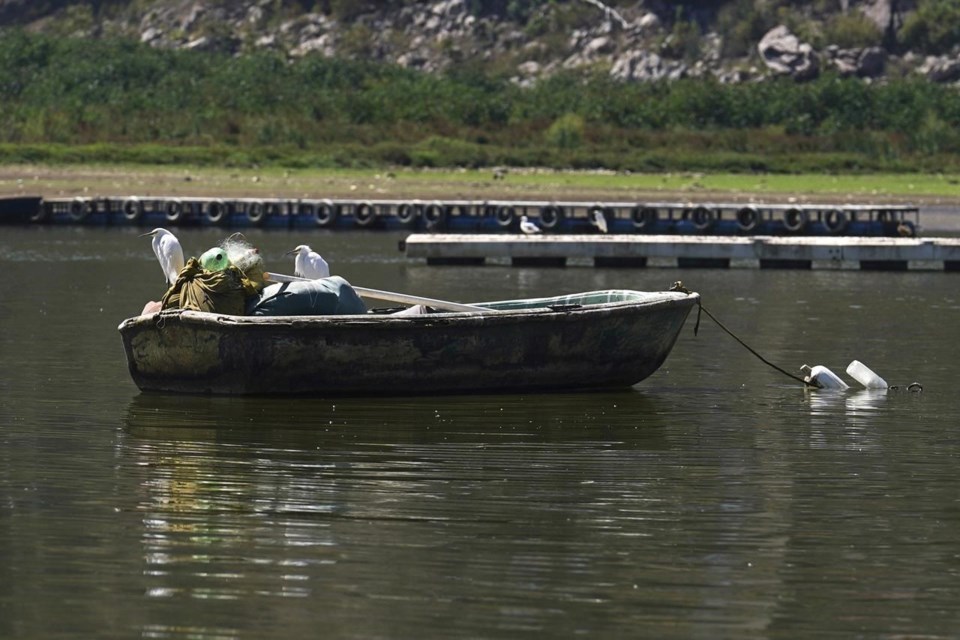VALLE DE BRAVO, Mexico (AP) — Once a glittering weekend getaway for wealthy residents of Mexico City, Valle de Bravo has been reduced to a shrinking, increasingly polluted patch of mud flats and water and lawlessness.
Residents said Thursday that Valle — as the reservoir has been known since the 1940s — is being drained by that waste much of its water, as well as the unrestrained construction of private dams and holding ponds by suspiciously wealthy and powerful newcomers.
In a country where the government appears not to listen and gang violence is common, residents and activists can only watch as their beloved lake disappears. The National Water Commission, known by its Spanish initials as Conagua, has done little to remedy the problem.
Moises Jaramillo is one of the tour boat operators who has made his living taking less-monied tourists around the lake for years (the wealthy use their own sailboats). Jaramillo says of the Conagua officials, “they don’t do anything. Their response is to come and intimidate us.”
That was a reference to a move last week by the Water Commission, which slapped closure stickers on the docks from where the boats launch.
To be fair, it is becoming increasingly difficult to lure any tourists to the lake; visitors now have to walk out a few dozen yards (meters) over mud flats on improvised paths of stones, tires and boards to reach the shrunken shore, putting up with the increasing green-brown color and smell of the water as they go.
Valle de Bravo resident Claudia Suárez was one of dozens of protesters who blocked traffic on one of Mexico City's main boulevards in February, demanding Conagua take action to address the real problem in a chain of three lakes — known as the Cutzamala System — that supply Mexico City with about one-quarter of its water.
“If there is money available, they could start repairing the leaks, above all in Mexico City,” said Suárez. “Forty percent of the water that comes from the Cutzamala System is lost to leaks. That's criminal.”
The problem is not only affecting poorer boat operators. As the title of an old Mexican soap opera says, “The Rich Cry, Too.”
“Valle de Bravo lives off this reservoir and basically, tourism,” said Suárez. “Tourism has gone down between 50 and 60%,” she said, adding “this is snowballing and affecting all levels; I think that property prices have fallen, too.”
Mexico´s version of the Hamptons, Valle de Bravo lies two hours from Mexico City. It is a haven for Mexico´s richest families, who congregate on weekends in wood and glass “cabins” with views of the lake or towering pine forests. They dine out at five-star restaurants and hold long, lavish lunches on lawns crowded with Hummers, BMWs and increasingly popular ATVs.
This week Valle de Bravo’s reservoir was at 29.3% of its capacity, compared to 52% during the same week last year. Conagua and Mexico City officials have brushed off concerns, saying the capital has agreed to temporarily reduce water deliveries to the over 20 million residents of the greater Mexico City area. The problem, they say, will be solved in June, when central Mexico's strongly seasonal rains begin again.
But Jaramillo says that's not true: the falling water levels have become a permanent problem that threatens the lake's very existence.
“Last year when it rained, the level of the lake still fell,” Jaramillo noted.
Everybody agree that beyond the very real drought late last year, there's an underlying problem. Increasingly since the coronavirus pandemic, there has been a huge increase in the development of luxury compounds with private lakes for water-skiing and swimming. That has prevented huge amounts of water from ever reaching the reservoir.
“There are a lot of people taking the water, the rivers almost run dry, and a lot of these (private) dams are 100% full,” said Suárez.
Jaramillo estimates there may be as many as 400 such private lakes or ponds of varying size near the lake, and that now, even with the water crisis, 15 more are under construction.
A local architect, who asked not be named for personal reasons — he built many of the upscale houses around the lake — denied that the relatively small private lakes and ponds are the problem, noting the volume of water they hold is a drop in the bucket. But he agreed that water extraction for Mexico City was a huge problem.
Either way, the authorities say they need local residents to file formal complaints about such private dams and reservoirs.
But Valle de Bravo sits at the edge of an area controlled by the extremely ruthless Familia Michoacana drug cartel, and Mexican gang leaders have a decades-long penchant for in upscale areas favored by other wealthy Mexicans.
Driving by gated homes and condominiums, or outside fancy restaurants in the area, it's not unusual to see men who could be bodyguards for wealthy businessmen — or cartel enforcers. It's usually wiser not to ask which.
“Conagua wants an individual person to point out every ranch, but that is impossible,” Jaramillo says. “No individual person is going to report them, because you don't know what kind of person owns those condominiums.”
Marco Ugarte, The Associated Press



